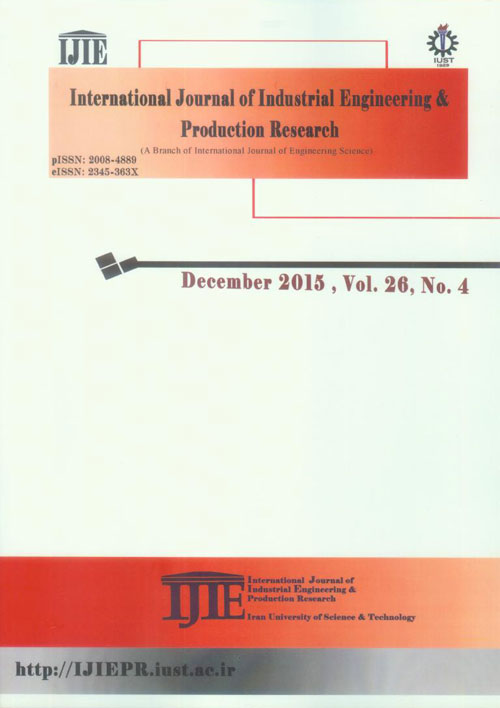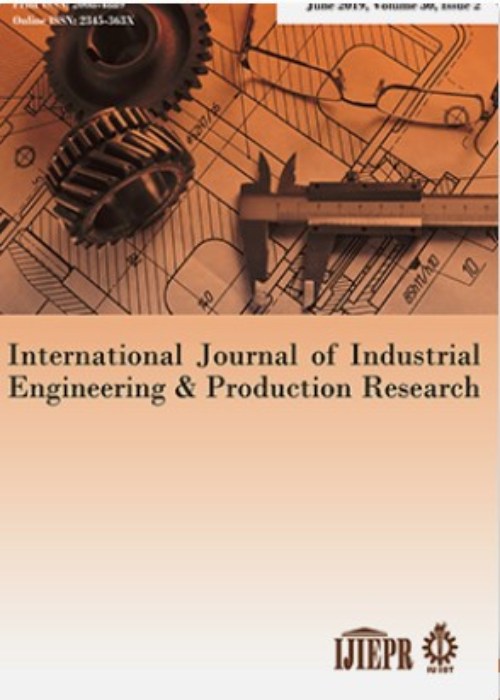فهرست مطالب

International Journal of Industrial Engineering and Productional Research
Volume:26 Issue: 4, Dec 2015
- تاریخ انتشار: 1395/02/01
- تعداد عناوین: 6
-
-
Pages 229-241Project management in construction industry¡ in many cases¡ is imperfect with respect to the integration of Occupational Health and Safety (OHS) risks. This imperfection exhibits itself as complications affecting the riskiness of industrial procedures and is illustrated usually by poor awareness of OHS within project teams. Difficulties on OHS regularly came about in the construction industry. The integration of OHS risk is not systematic in construction areas in spite of progressing laws and management systems. As project safety and risk evaluation in construction industry is an important issue¡ thus¡ the way on doing evaluation and liability of estimation is necessary. In this paper¡ we propose a new systematic approach based on Latin Hypercube Sampling (LHS) for integrating occupational health and safety into project risk evaluation. This approach tries to identify and evaluate reinforcement effects in a systematic approach for integrating OHS risks into project risk assessment. Furthermore¡ the proposed method allows evaluating and comparing OHS risks before and after the mitigation plan. A case study is used to prove the workability¡ credibility of the risk evaluation approach and uncomplicated integration of OHS risks at a construction project. This approach enables continual revaluation of criteria over the direction of the project or when new information is obtained. This model enables the decision makers such as project managers to integrate OHS risks toward schedule plan and compare them before and after the mitigation plan. The mentioned model is found to be useful for predicting OHS risks in construction industries and thus avoiding accidents over the path of the project.Keywords: Occupational health, safety (OHS), Project management, Latin hypercube sampling (LHS), Risk assessment, Construction
-
Pages 243-253This article addresses a single row facility layout problem where the objective is to optimize the arrangement of some rectangular facilities with different dimensions on a line. Regarding the NP-Hard nature of the considered problem, a hybrid meta-heuristic algorithm based on simulated annealing has been proposed to obtain a near optimal solution. A number of test problems are randomly generated and the results obtained by the proposed hybrid meta-heuristic are compared with exact solutions. The results imply that the proposed hybrid method provides more efficient solutions for the large-sized problem instances.Keywords: Flexible Manufacturing System, Single Row Facility Layout Problem, Simulated Annealing
-
Pages 255-268Data envelopment analysis (DEA) and balanced scorecard (BSC) are two well-known approaches for measuring performance of decision making units (DMUs). BSC is especially applied with quality measures, whereas, when the quantity measures are used to evaluate, DEA is more appropriate. In the real-world, DMUs usually have complex structures such as network structures. One of the well-known network structures is two-stage processes with intermediate measures. In this structure, there are two stages and each stage uses inputs to produce outputs separately where the first stage outputs are inputs for the second stage. This paper deals with integrated DEA and game theory approaches for evaluating two-stage processes. In addition, it is an extension of DEA model based on BSC perspectives. BSC is used to categorize the efficiency measures under two-stage process. Furthermore, we propose a two-stage DEA model with considering leader-follower structure and including multiple sub stages in the follower stage. To determine importance of each category of measures in a competitive environment, cooperative and non-cooperative game approaches are used. A case study for measuring performance of power plants in Iran is presented to show the abilities of the proposed approach.Keywords: Thermal Power plant, Data envelopment analysis, Game theory, Balanced scorecard, Competitive environment
-
Pages 269-285The present paper aims to investigate the effects of modularity and the layout of subsystems and parts of a complex system on its maintainability. For this purpose, four objective functions have been considered simultaneously: I) maximizing the level of accordance between system design and optimum modularity design,II) maximizing the level of accessibility and the maintenance space required,III) maximizing the providing of distance requirement and IV) minimizing the layout space. The first objective function has been put forward for the first time in the present paper and in it, the optimum system modularity design was determined using the Design Structure Matrix (DSM) technique.The second objective function is combined with the concept of Level of Repair Analysis (LoRA) and developed. Simultaneous optimization of the above-mentioned objective functions has not been considered in previous studies. The multi objective problem which has been put forward was applied on a laser range finder containing 17 subsystems and the modularity and optimum layout was determined using a multi objective particle swarm optimization (MOPSO) algorithm.Keywords: Maintainability, Modulation, Layout, DSM:Design Structure Matrix, Multi Objective Problem, MOPSO: Multi Objective Particle Swarm Optimization, Laser Range Finder
-
Pages 287-309In todays competitive business situation, performance evaluation of firms is an extremely important concern of all the people who are typically stakeholders of the business game. In case of holding companies, this is a more important issue since the parent firm must permanently control the situation of its subsidiaries in their sectors to make appropriate investment decisions. This paper develops a multicriteria decision making (MCDM) approach for evaluating performance of firms considering financial and productivity criteria. We adopt a Fuzzy Analytic Hierarchy Process (FAHP) method to determine the relative importance of evaluation criteria, taking the vagueness and imprecision of human judgments into consideration. Then, we employ the Preference Ranking Organization METHod for Enrichment Evaluation (PROMETHEE) for ranking of firms. Afterward, this paper enjoys benefit of using Technique of Order Preference by Similarity to Ideal Solution (TOPSIS) to assess the validity of the obtained ranking results. Our approach was applied to a holding company listed in Tehran Stock Exchange (TSE) as a real case. The analysis of ranking results revealed advantages of combining these MCDM methods.Keywords: Multiple criteria decision making, Performance evaluation, Fuzzy AHP, PROMETHEE, TOPSIS, Holding company.
-
Pages 311-333The concept of "complexity" is familiar to many of project's managers; however, it is not comprehended by all in the same way. Researches conducted on this field have shown that the authors have difference understanding of "complexity" and their understanding mainly depends on their points of view. In fact, many identified aspects of the complexity in the literature are related to the aims of the research. This paper is an attempt to describe the complexity of project using three approaches; research literature(manufacturing and project complexity), interviews (deep interview with 20 experts) and questionnaire. The research was conducted on the Complex product and system (CoPS) projects. In addition, WH question technique was used. In conclusion, a 5p model (Purpose, Product, Process, People, and Peripheral) was introduced.Keywords: Complexity, Project Complexity, Manufacturing complexity, Factors of complexity, Modeling Complexity, conceptual model


